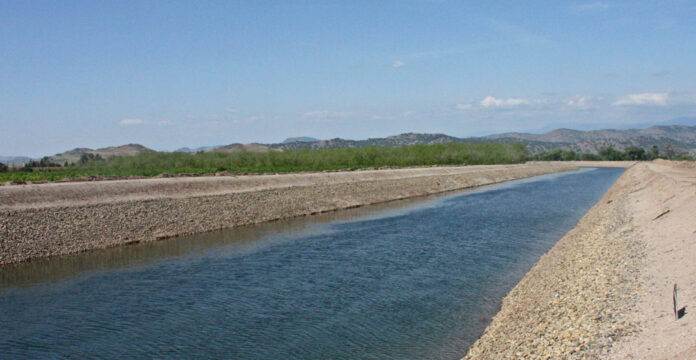The Tulare Irrigation District held its board of directors meeting on the second Tuesday of the month, October 10, 2023. Whenever the first falls on a Sunday the month will have a Friday the 13th. There will be one this week. While preparing and doing my usual intense and highly focused research for this report I double checked the calendar to affirm this is really the second Tuesday. That’s when I noticed we’re going to have a Friday the 13th this week. Friday the 12th or the 14th and most of the time Friday the 13th comes and goes without my notice. I’ve never been bothered by that combination of day of the week and date of the month. It just doesn’t scare me. Why? Because I’m brave? Not particularly brave no. It’s superstition and of course I’m beyond that. I’m a grown man, I got my four year degree in 13 years and Friday is the day I get to stay up late if I want and increasingly as the years roll by, if I can.
and highly focused research for this report I double checked the calendar to affirm this is really the second Tuesday. That’s when I noticed we’re going to have a Friday the 13th this week. Friday the 12th or the 14th and most of the time Friday the 13th comes and goes without my notice. I’ve never been bothered by that combination of day of the week and date of the month. It just doesn’t scare me. Why? Because I’m brave? Not particularly brave no. It’s superstition and of course I’m beyond that. I’m a grown man, I got my four year degree in 13 years and Friday is the day I get to stay up late if I want and increasingly as the years roll by, if I can.
When looking back it came to me I used to have a big superstition in my life. Putting a hat on a bed could clear a room when I was competing in rodeos and nobody ever put their hat on a bed. I had no idea at the time why it was considered such bad luck. I found out later it is considered terribly bad manners in some parts of the country. Evidently back before personal hygiene was as easily achieved as it is today lice were known to jump on and off of clothing. No one wanted lice from someone’s bed getting in their hat and no one wanted lice from someone’s hat getting into their bed. Once an ex of mine was angrier than usual and put all of my hats on our bed. For all I know she stuck pins into a doll too. I got in a car wreck that day. But I’m not superstitious, I just don’t put hats on beds to show good manners.
is considered terribly bad manners in some parts of the country. Evidently back before personal hygiene was as easily achieved as it is today lice were known to jump on and off of clothing. No one wanted lice from someone’s bed getting in their hat and no one wanted lice from someone’s hat getting into their bed. Once an ex of mine was angrier than usual and put all of my hats on our bed. For all I know she stuck pins into a doll too. I got in a car wreck that day. But I’m not superstitious, I just don’t put hats on beds to show good manners.
Superstition is a lack of faith; or perhaps more accurately, a substitute for faith. We are going to look back someday on the times we now live in and wonder at the primitive beliefs and barbarity.
The Meeting
Things kicked off with Chairman David Bixler calling the meeting at 9:03am. General Manager Aaron Fukuda introduced a young man from Hanford who asked to job shadow the TID staff and he was welcomed.
The Water Report
Water Master Marco Crenshaw gave his report saying Lake Kaweah is holding about 20,000 a/f in storage. Millerton Lake is storing about 181,000 a/f. Crenshaw showed a chart going back to 1950. This year 2023 set the record for the most diversions ever in TID, more than 400,000 a/f. Good for them. As Crenshaw said it was a busy year. Fukuda said TID will be sending a newsletter out to growers to announce a workshop to show what’s happened and what can happen in the future.
TID stopped deliveries at the first of this month to allow construction and maintenance of the facilities. The Friant Kern Canal will de-water over the holidays but TID should be completely ready when the time comes to start moving water. As you can imagine this year’s water output stretched most of the district’s facilities to the edge and maintenance and repairs will be very necessary.
Director Dave Martin asked if the district had the facilities could it have taken more water. Fukuda said probably not more Central Valley Project/Friant water because it was inundated with Kaweah River water. The goal was to move that river water away from Tulare Lake so as not to exacerbate flooding.
There are new projections daily about this year’s precipitation. Many say an El Nino year will bring another normal to wet year. Other methods show Southern California getting the bulk of the rainfall this year. Partially due to more storms moving from the west to the east at a more southernly pace and the storms that usually hit the Pacific Northwest are moving further inland from the Gulf of Alaska sooner. Currently the state’s reservoirs are doing exceptionally well and we can enter 2024 in better shape.
Fukuda said 2023 almost hit the Tulare Basin record and had the last storm, Hurricane Hillary swerved just further north a little it surely would have broken the record.
O&M Report
Superintendent Wayne Fox reported crews are prepared to take on the aquatic weeds in the District. Checks, turnouts, canal banks, any other structures are being tended to. Fox and Fukuda said the same thing – the TID crew couldn’t have done better. Everyone pitched in, took an exceptionally wet year and made it pay off. Good for them. Fox said management is looking to hire new staff and have been conducting interviews.
Fox reported the district’s fleet needs help after this past year. Dump trucks are vital but it looks like renting one won’t payoff as well as a purchase. But it sounded like there won’t be a model comparable to the current truck available until next April at the earliest. Fox and friends presented the board with three or four options. Director Scott Rogers oversaw the process and said he felt confident the options are the best available.
friends presented the board with three or four options. Director Scott Rogers oversaw the process and said he felt confident the options are the best available.
Here’s a problem for everyone in California. The wishful thinkers in Sacramento want to convert the state entirely to electric vehicles. I have never heard any responsible adult say this is even remotely possible. We don’t have the infrastructure, the power supply or physics on our side to make this happen. It’s as if the government leadership have reverted to a playground full of five year old’s skipping across the playground singing we’re going electric because mom and dad’s going pay for it with their magic ATM card.
Financials
Fiscal Goddess* Kathi Artis gave her report and it was as good as ever. TID made $12 million so far. It sounded like that was more than it spent. So, if TID owes you money it can and will pay you. That’s got to feel good. A solvent district is a happy district. But don’t take it lightly. A review of the bills elicits quite in the boardroom as a farmers look over the figures.
million so far. It sounded like that was more than it spent. So, if TID owes you money it can and will pay you. That’s got to feel good. A solvent district is a happy district. But don’t take it lightly. A review of the bills elicits quite in the boardroom as a farmers look over the figures.
Engineering
Next engineering. I just noticed down at the bottom of the report I’ve been listing Jeremy Barroll as the engineer. Barroll moved on and it’s been a while so I don’t recall where he went. TID hasn’t filled that position yet. BTW – we try to provide readers with some context at the bottom of the page when we can. It looks like fine print boilerplate but our hope is it will inform readers about the agency being written about. Like most technical endeavors there is a great deal of specialized jargon and abbreviations in irrigation. We had developed a glossary and it’s around here somewhere. Perhaps we need to publish it again. Your thoughts?
Fukuda gave the engineering report and that often deals a lot with construction. As word of California’s San Joaquin Valley’s quality of life becomes wider known development continues to expand urban areas. This bumps up against districts up and down the Valley. Canals, pipes, pumping stations all are impacted. Fukuda said he’s talking with the City of Tulare about developing a standardized procedure to protect both TID and the City while providing clarity to developers going into any proposal. They are looking at the option of moving TID facilities to a new location.
California’s San Joaquin Valley’s quality of life becomes wider known development continues to expand urban areas. This bumps up against districts up and down the Valley. Canals, pipes, pumping stations all are impacted. Fukuda said he’s talking with the City of Tulare about developing a standardized procedure to protect both TID and the City while providing clarity to developers going into any proposal. They are looking at the option of moving TID facilities to a new location.
Staff Report
Fukuda reported the Kaweah Subbasin is continuing to set criteria on allocations and other SGMA measurements. The last subbasin coordination meeting included reports from the Natural Resource Conservation District on how to help individuals. The Mid Kaweah Groundwater Sustainability Agency is recommending a 25-year rolling average with  a maximum pumping of three a/f. This includes a native yield of .83 a/f, with a Tier One of .5 a/f and Tier Two of .5 a/f. The East Kaweah GSA wants a native yield of .85 a/f, a mitigation bloc of .05 a/f and a 92 percent 25-year rolling average. There’s more rainfall against the foothills but the mitigation figure is almost nothing.
a maximum pumping of three a/f. This includes a native yield of .83 a/f, with a Tier One of .5 a/f and Tier Two of .5 a/f. The East Kaweah GSA wants a native yield of .85 a/f, a mitigation bloc of .05 a/f and a 92 percent 25-year rolling average. There’s more rainfall against the foothills but the mitigation figure is almost nothing.
The Greater Kaweah GSA over allocated a good deal of water last year and the other players in the subbasin aren’t jiggy with the GKGSA figures. There was a vote last month on allocations that was voided and will have to be recast in the near future. Emergency ordinance pumping limits are also being considered.
Friant Matters
Operations, Maintenance and Restoration spending on the Friant Division of the CVP isn’t getting any cheaper. At the last meeting a cost of living increase of 3.7 percent was granted. There was also a presentation on repairing the middle reach of the Friant Kern Canal. Fukuda said the work is building the height of the new portion of the canal to what it was and a little more to take subsidence already underway. He said standing at the bottom and looking up is a jolting illustration of how much subsidence has taken place. Someone brought up a question I’d not heard or considered. What is going to happen to the old channel that will no longer be used? As Fukuda said it could become a repository of no longer valued objects such as old couches, cars and crap.
granted. There was also a presentation on repairing the middle reach of the Friant Kern Canal. Fukuda said the work is building the height of the new portion of the canal to what it was and a little more to take subsidence already underway. He said standing at the bottom and looking up is a jolting illustration of how much subsidence has taken place. Someone brought up a question I’d not heard or considered. What is going to happen to the old channel that will no longer be used? As Fukuda said it could become a repository of no longer valued objects such as old couches, cars and crap.
GM Report
Fukuda listed a long string of stuff where he’s speaking. He’s turning into the rock star of irrigation. ACWA is offering TID a Certificate of Excellence as a charter member of the ACWA’s Certificate of Excellence award. Much like the Star of Fame on the Hollywood Boulevard sidewalk, this is an honor that has to be purchased.
Fukuda said engineering firm Provost & Pritchard wants to redesign TID’s website. He said P&P has been doing website design for water agencies for some time. He said a deal with P&P designs but TID and MKGSA will be paying $6,500 each for this. It will take a month and half on the outside. P&P will host but TID & MKGSA will populate content. The board went for it.
Resolutions
Number 2023-11, 12 and 13, for the assessment rate, an application to the US Bureau of Reclamation for a Fiscal Year 2024 Drought Resiliency Project fund were the topics and an application for a Water SMART grant – respectively.
Fukuda wanted to tinker with how assessments have been set. He said using the Consumer Price Index could be a method – specifically the month of May rate – and apply this to the assessment rate. When a district wants to increase its assessment rate it has to hold and pass what’s known as a 218 Election. The results set the range of assessments from minimum to maximum that can be imposed on growers’ acreage. If I understand this proposal Fukuda is advocating to start at the low end of the assessment range and link the rate to increases in each year’s May CPI. I believe the current link is to the Cost of Living Adjustment.
Fukuda said when developing budgets you have start with an average year, although there is never an “average” year. You really don’t know what you have until June or July for a water year. TID’s average income and expense is around $12 million each. Fukuda put some really hard to read, busy and complicated bed spread and sheet on the screen that somehow explained all this. I will leave you with this – the resolution is required to change the method. There was a good deal of discussion and the result was a resolution was passed.
The second resolution wasn’t nearly as intense. A grant from the USBR will help with the Okieville Well resiliency project and a five percent cost share from TID to be split with Self Help Enterprises. These funds will provide a backup well and I believe an elevated water tank. Water tanks provide firefighting water even when the power goes out, like it often does during a fire. It also gives you a little storage if the pump or the well goes out. I swear I heard Fukuda say DWR’s Karla Nemeth wrote a letter of support for this. Good for her. In addition to matching funds a resolution has to be passed and it was.
swear I heard Fukuda say DWR’s Karla Nemeth wrote a letter of support for this. Good for her. In addition to matching funds a resolution has to be passed and it was.
The last resolution is an inhouse grant application to develop a water dashboard for TID. Fukuda said he’s wanted to incorporate this for some time but they didn’t have any water for a couple of years so it wasn’t a priority. He said right now the data comes from everywhere in all kinds of forms. He said Crenshaw has been having to collect and compile this data and it’s a very big job. The dashboard will take care of much of this. The board approved.
Director Reports & Closed Session
This is where the directors get everyone else caught up with what they’ve been up to. There weren’t any reports this time and the meeting went into closed session at 11:32am for four cases of litigation, some liability claims and personnel matters. Good for them but good for me for not having to cover it.
Well, that’s all from TID this month. Go be good to each other.
DISCLAIMER OF RESPONSIBILITY; Waterwrights strives to provide clients with the most complete, up-to-date, and accurate information available. Nevertheless, Waterwrights does not serve as a guarantor of the accuracy or completeness of the information provided, and specifically disclaims any and all responsibility for information that is not accurate, up-to-date, or complete. Waterwrights’ clients therefore rely on the accuracy, completeness and timeliness of information from Waterwrights entirely at their own risk. The opinions expressed in this report are those of the author and do not represent any advertisers or third parties.
*Controller sounds too, I don’t know, controlling.
ALL RIGHTS RESERVED. Copyright 2023 by WaterWrights.net/DAW
TULARE IRRIGATION DISTRICT
6826 Ave 240, Tulare, CA 93274 Office: 559/686-3425
Board: David G. Bixler- President, Richard S. Borges, Jr.-Vice President, Scott Rogers, Dave Martin & Michael Thomas
Staff: Aaron Fukuda-General Manager, Kathi Artis–District Controller, Wayne Fox–Superintendent, Marco Crenshaw–District Watermaster & Alex Peltzer-Attorney.
About: The Tulare Irrigation District was organized September 21, 1889. The original proposal for the formation of an irrigation district covering 219,000 acres, extending from the Sierra Nevada foothills to Tulare Lake, was eventually reduced to 32,500 acres. The District continued in this status until January of 1948 when the so-called Kaweah Lands” (approximately 11,000 acres) were annexed. In October of 1948, approximately 31,000 acres, compromising the area served by the Packwood Canal Company were annexed to the District. A U.S. Bureau of Reclamation contract was signed in 1950 providing an annual supply of 30,000 acre-feet of Class 1 water, and up to 141,000 acre-feet of Class 2 water from the Friant-Kern Canal. The District and the Kaweah Delta Water Conservation District have coordinated efforts to enhance the recharge of groundwater within the Kaweah Basin. During high flow times KDWCD may use the recharge basins with the District for recharge purposes. Further, KDWCD has historically provided for a financial incentive program through which the District sustains the level of groundwater recharge from supply sources into the District. This historical program was recently reinstated by both districts in lieu of the District’s plans to concrete-line this canal to conserve the surface water. TID is a member of the Mid Kaweah GSA DWR#-5-022.11

































